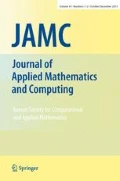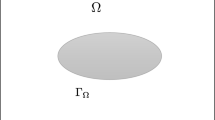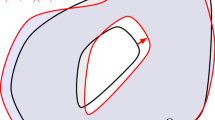Abstract
In this work, a class of bilateral free boundary problem is considered. This identification problem is formulated as a shape optimization problem via the definition of a cost functional. The existence of an optimal solution for the optimization problem is proved. An augmented Lagrangian approach is used to facilitate the computation of the shape derivatives. A numerical approach is proposed to solve iteratively the shape optimization problem, also we prove its convergence. Various type of domains are investigated to confirm the validity of the presented approach. For the numerical stability we investigate the shape without and with noisy data.







Similar content being viewed by others
References
Amstutz, S.: Augmented Lagrangian for cone constrained topology optimization. Comput. Optim. Appl. 49(1), 101–122 (2011). https://doi.org/10.1007/s10589-009-9272-3
Cea, J.: Conception optimale ou identification de formes, calcul rapide de la dérivée directionnelle de la fonction coût. Modélisation mathématique et analyse numérique 20(3), 371–402 (1986)
Chakib, A., Ellabib, A., Nachaoui, A., Nachaoui, M.: A shape optimization formulation of weld pool determination. Appl. Math. Lett. 25(3), 374–379 (2012). https://doi.org/10.1016/j.aml.2011.09.017
Ciarlet, P.G.: The finite element method for elliptic problems. Soc. Ind. Appl. Math. (2002). https://doi.org/10.1137/1.9780898719208
Conn, A.R., Gould, N.I.M., Toint, P.: A globally convergent augmented Lagrangian algorithm for optimization with general constraints and simple bounds. SIAM J. Numer. Anal. 28(2), 545–572 (1991). https://doi.org/10.1137/0728030
Dai, Y.H.: Convergence properties of the BFGS algorithm. SIAM J. Optim. 13(3), 693–701 (2002)
Dashti Ardakani, M., Khodadad, M.: Shape estimation of a cavity by inverse application of the 2D elastostatics problem. Int. J. Comput. Methods 10(06), 1350042 (2013). https://doi.org/10.1142/S0219876213500424
Delfour, M.C., Zolésio, J.P.: Shapes and geometries. Soc. Ind. Appl. Math. (2011). https://doi.org/10.1137/1.9780898719826
Dimakopoulos, Y., Makrigiorgos, G., Georgiou, G.C., Tsamopoulos, J.: The PAL (penalized augmented Lagrangian) method for computing viscoplastic flows: a new fast converging scheme. J. Nonnewton. Fluid Mech. 256, 23–41 (2018). https://doi.org/10.1016/j.jnnfm.2018.03.009
Dimakopoulos, Y., Pavlidis, M., Tsamopoulos, J.: Steady bubble rise in Herschel–Bulkley fluids and comparison of predictions via the augmented Lagrangian method with those via the Papanastasiou model. J. Nonnewton. Fluid Mech. 200, 34–51 (2013). https://doi.org/10.1016/j.jnnfm.2012.10.012
El Yazidi, Y., Ellabib, A.: Reconstruction of the depletion layer in MOSFET by genetic algorithms. Math. Model. Comput. 7(1), 96–103 (2020). https://doi.org/10.23939/mmc2020.01.096
Ellabib, A., Nachaoui, A.: On the numerical solution of a free boundary identification problem. Inverse Probl. Eng. 9(3), 235–260 (2001). https://doi.org/10.1080/174159701088027764
Glowinski, R., Fortin, M.: Augmented Lagrangian Methods Applications to the Numerical Solution of Boundary-Value Problems. Elsevier, Amsterdam (1983)
Glowinski, R., Le Tallec, P.: Numerical solution of problems in incompressible finite elasticity by augmented Lagrangian methods. I. Two-dimensional and axisymmetric problems. SIAM J. Appl. Math. 42(2), 400–429 (1982). https://doi.org/10.1137/0142031
Haslinger, J., Mäkinen, R.A.E.: Introduction to Shape Optimization: Theory, Approximation, and Computation. SIAM, Philadelphia (2003)
Huang, C.H., Shih, C.C.: A shape identification problem in estimating simultaneously two interfacial configurations in a multiple region domain. Appl. Therm. Eng. 26(1), 77–88 (2006). https://doi.org/10.1016/j.applthermaleng.2005.04.019
Liu, J.C.: Shape reconstruction of conductivity interface problems. Int. J. Comput. Methods 16(01), 1850092 (2018). https://doi.org/10.1142/S0219876218500925
Mozaffari, M.H., Khodadad, M., Dashti Ardakani, M.: Simultaneous identification of multi-irregular interfacial boundary configurations in non-homogeneous body using surface displacement measurements. J. Mech. Eng. Sci. 231(13), 1–12 (2016). https://doi.org/10.1177/0954406216636166
Nazemi, A.R., Farahi, M.H., Zamirian, M.: Filtration problem in inhomogeneous dam by using embedding method. J. Appl. Math. Comput. 28(1), 313 (2008). https://doi.org/10.1007/s12190-008-0107-7
Nocedal, J., Wright, S.J.: Numerical Optimization. Springer, New York (2006). https://doi.org/10.1007/978-0-387-40065-5
Pironneau, O.: Optimal Shape Design for Elliptic Systems. Springer, Berlin (1982). https://doi.org/10.1007/BFb0006123
Powell, M.: Some global convergence properties of a variable metric algorithm for minimization without exact line searches. In: Nonlinear Programming: Proceedings of a Symposium in Applied Mathematics, pp. 53–72 (1976)
Rudin, W.: Functional Analysis. McGraw-Hill, New York (1991)
Vogel, C.R.: Computational methods for inverse problems. Soc. Ind. Appl. Math. (2002). https://doi.org/10.1137/1.9780898717570
Wang, Z., Zhu, D.: A filter-line-search method for unconstrained optimization. J. Appl. Math. Comput. 34(1), 329–342 (2010). https://doi.org/10.1007/s12190-009-0324-8
Zhang, R., Sun, J.: The reconstruction of obstacles in a waveguide using finite elements. J. Comput. Math. 36(1), 29–46 (2018). https://doi.org/10.4208/jcm.1610-m2016-0559
Zolesio, J.P., Sokolowski, J.: Introduction to Shape Optimization Shape Sensitivity Analysis. Springer, Berlin (1992)
Author information
Authors and Affiliations
Corresponding author
Additional information
Publisher's Note
Springer Nature remains neutral with regard to jurisdictional claims in published maps and institutional affiliations.
Rights and permissions
About this article
Cite this article
El Yazidi, Y., Ellabib, A. Augmented Lagrangian approach for a bilateral free boundary problem. J. Appl. Math. Comput. 67, 69–88 (2021). https://doi.org/10.1007/s12190-020-01472-y
Received:
Revised:
Accepted:
Published:
Issue Date:
DOI: https://doi.org/10.1007/s12190-020-01472-y




